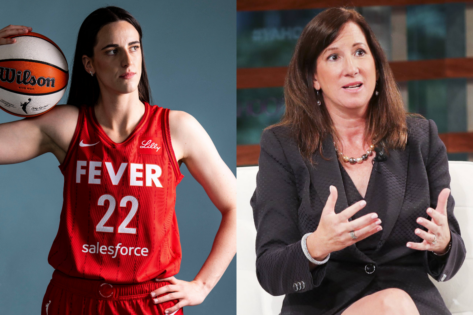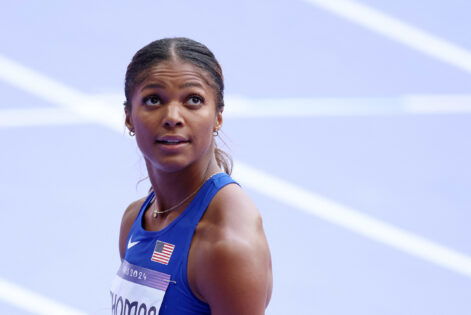The last time the WNBA really thrived in attendance, it was 2002, back when people were probably choosing to watch Tamika Catchings’ Rookie of the Year campaign over the debut of American Idol. Or maybe they were showing up for Sheryl Swoopes’ MVP run, or Lisa Leslie adding building herself for DPOYs. And honestly, what else would you expect from a season that also introduced Sue Bird as the No. 1 pick? Nothing short of iconic, of course, and the numbers in the stands proved it. Now here in 2025, the vibe feels familiar. Caitlin Clark’s sophomore sway, Paige Bueckers’ rookie ramp-up, and the steady dominance of A’ja Wilson and Napheesa Collier are pulling eyes and filling arenas. Here, you’ve got another season that feels destined to go down as a classic.
As one more similarity, 2002 wasn’t just about the stars on the court; it was also the year they demanded change. Lesbians for Liberty took it grassroots: they handed out flyers with sharp humor, stickers like “Lesbian Fans Are Filling the Stands,” even timeout protests where groups stood up and kissed. Fast-forward to 2025, and this generation is also pushing back. They are warming up in “Pay us what you owe us” shirts after CBA talks stalled. The players’ message is blunt: with revenues soaring past $200 million and attendance at historic highs, the league can’t hide behind an “agreement” anymore. And really, it’s only fair. The players saw the $50 million price tag for Golden State Valkyries and knew exactly what that signals: the WNBA is a hot investment because it’s growing, fast.
Need proof? You don’t even have to squint. The WNBA blew past its all-time attendance record this summer. The league surpassed the 2002 mark of 2,364,736 fans in just 215 games. That is 41 fewer than it took back then, and at the heart of it is the same $50 million expansion franchise. The Golden State Valkyries have sold out all 16 of their home games at Chase Center (nearly 290,000 fans already through the gates). Meanwhile, Indiana has kept on leading the league. They crossed 300,000 fans through 18 home games, per FOS. This number, even though Caitlin Clark has only suited up for eight of them because of her quad and groin injury.
The WNBA has broken its all-time regular season attendance record—with a month still left in the season.
Over 2.3 million fans have attended WNBA games this season. pic.twitter.com/3gruzfKPcp
— Front Office Sports (@FOS) August 19, 2025
But the hope is that she’ll be back before the postseason. “That’s the hope,” head coach Stephanie White repeated when pressed about her timeline. But even on the sidelines, Caitlin Clark’s impact is undeniable. Her rookie season still ranks third all-time in attendance. It is trailing only the iconic 2002 campaign and this very year. Her arrival was the spark. But 2025 is the year when the WNBA doesn’t need explosive headlines; people are showing up for the craze of it. Moreover, it’s not just Indiana carrying the surge.
The New York Liberty have also packed Barclays historically. They are averaging 29% more fans per game than last season. They’ve already outpaced their entire 2024 attendance total by nearly 25,000 fans. All that, despite having played three fewer home games so far. So now, the league is on pace to clear the three-million mark in total attendance for the first time ever. This is all set to only grow with the expansion markets already inked in for Toronto and Portland (2026), Cleveland (2028), Detroit (2029), and Philadelphia (2030).
But can metrics hide this season’s injury toll, especially when it comes to the Indiana Fever?
We knew what this longer schedule in the same tightened window was going to bring. And the Indiana Fever’s run has been a glaring example. Besides that, the inconsistent officiating hasn’t helped much. Their 2025 season has been badly hurt by injuries, and the most recent setback happened when Sophie Cunningham suffered a devastating right knee injury. It happened during the recent game against the Connecticut Sun. A collision with Bria Hartley caused the 29-year-old veteran to be in visible pain, and a subsequent MRI confirmed a torn MCL that will keep her out for the remainder of the season, including the playoffs.
This is a brutal loss for the team, which was already dealing with the long-term absences of Sydney Colson, who has an ACL injury, and Aari McDonald, who has a foot fracture. Sophie Cunningham had been providing a steady hand for the Fever throughout all the chaos. She was averaging 8.6 points, 3.5 rebounds, and 1.2 assists over 30 games, and she frequently had to step into larger roles whenever the roster got thin.
Her season-ending injury stretches the team’s guard rotation to its absolute limits. This has forced the front office to rely heavily on hardship signings. Odyssey Sims and Chloe Bibby have already been brought in to help stabilize the backcourt, while Kyra Lambert (who was briefly part of the mix) had her seven-day contract cut short. Now, with Cunningham joining Caitlin Clark, Colson, and McDonald on the sidelines, Indiana was left with no choice but to sign yet another hardship deal.
On August 19, they signed their fifth replacement player of this season. It is the veteran guard Shey Peddy, she’s now with the Fever on a seven-day contract. Peddy, who is known for her defensive grit and versatility, last played for the Los Angeles Sparks back in June. There she averaged 5 points, 3 rebounds, and 2.7 assists in 23 minutes per game. For the Fever, the hope is straightforward: that her experience and toughness can buy them some time, help stabilize the rotations, and maybe even help them win a few crucial games down the final stretch.
How long can these quick fixes really hold up? The hardship contract may offer temporary relief for injury-hit teams, but the fact that three squads have already relied on it within the first month of the WNBA season raises serious concerns.
The post WNBA Thrives in Top Business Metric Despite Caitlin Clark Absence, Players’ Pay Conflict appeared first on EssentiallySports.



